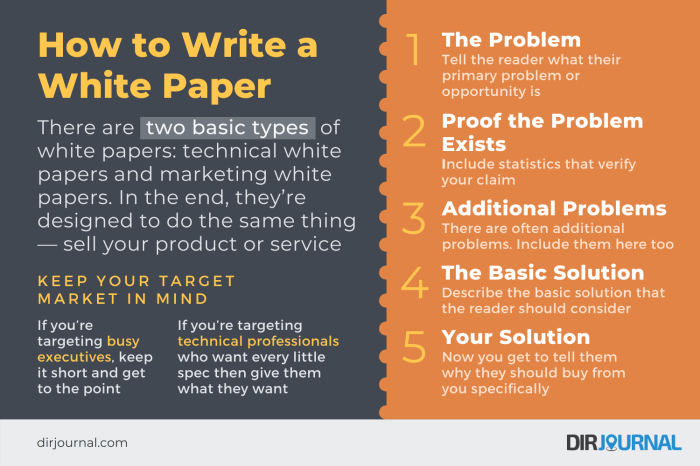Writing Whitepapers kicks off with a deep dive into the art of crafting compelling business documents, showcasing the importance of this valuable tool in modern marketing strategies. From defining whitepapers to exploring their impact across various industries, this topic sets the stage for an insightful journey into the world of professional writing.
As we delve into the essential components, effective research methods, writing styles, and visual elements of whitepapers, get ready to sharpen your skills and elevate your content creation game to the next level.
Introduction to Writing Whitepapers

Whitepapers are detailed reports that provide in-depth information about a particular topic or issue. In business, whitepapers are commonly used to educate readers about a specific industry trend, technology, or product. They serve as a valuable tool for businesses to establish their authority and expertise in a particular subject area.
Importance of Whitepapers in Marketing Strategies
Whitepapers play a crucial role in marketing strategies by helping businesses attract and engage potential customers. They provide valuable insights and information that can help address the pain points of target audiences. By offering solutions and expertise in a whitepaper, businesses can establish credibility and build trust with their audience.
- Whitepapers can be used as lead magnets to capture valuable contact information from potential customers.
- They can help businesses generate leads and nurture them through the sales funnel.
- Whitepapers can differentiate a business from competitors by showcasing unique insights and thought leadership.
Examples of Industries that Commonly Use Whitepapers
Whitepapers are commonly used in industries such as technology, finance, healthcare, and marketing. These industries often deal with complex topics and trends that require detailed explanations and analysis. By publishing whitepapers, businesses in these industries can showcase their expertise and provide valuable information to their target audience.
- Technology: Tech companies often use whitepapers to explain new technologies, trends, and innovations in the industry.
- Finance: Financial institutions use whitepapers to provide insights into market trends, investment strategies, and regulatory changes.
- Healthcare: Healthcare organizations use whitepapers to educate patients and professionals about new treatments, research findings, and healthcare policies.
- Marketing: Marketing agencies use whitepapers to share best practices, case studies, and industry insights with clients and prospects.
Components of a Whitepaper
When it comes to writing a whitepaper, there are several essential sections that are typically included to ensure the document is well-structured and informative. These components help guide the reader through the problem, solution, and key insights presented in the whitepaper.
Executive Summary
The executive summary is a crucial part of any whitepaper as it provides a concise overview of the main points discussed in the document. It should highlight the key findings, recommendations, and insights presented in the whitepaper, giving readers a quick understanding of what to expect before diving into the details.
Problem Statement and Solution
In a whitepaper, it is important to clearly define the problem or challenge that is being addressed. This helps set the context for the rest of the document and allows readers to understand the significance of the issue at hand. The solution section should then Artikel the proposed strategies, recommendations, or actions to address the problem effectively. By structuring the problem statement and solution clearly, readers can follow the logical flow of the whitepaper and grasp the intended message efficiently.
Research and Data Collection: Writing Whitepapers

When it comes to writing a whitepaper, conducting thorough research and collecting relevant data are crucial steps in creating a well-informed and comprehensive document. Research helps in providing credibility to your whitepaper by backing up your claims with evidence and data.
Importance of Using Credible Sources and Data, Writing Whitepapers
Utilizing credible sources and data is essential to ensure the accuracy and reliability of the information presented in your whitepaper. When you cite reputable sources and reliable data, it enhances the credibility of your content and makes your arguments more persuasive. Always cross-check information from multiple sources to avoid bias and ensure accuracy.
Tips on Organizing and Synthesizing Research Findings
– Create an Artikel: Before diving into your research, Artikel the key points you want to cover in your whitepaper. This will help you stay focused and organized during the research process.
– Use a variety of sources: To provide a well-rounded perspective on the topic, gather information from a mix of sources such as academic journals, industry reports, and expert interviews.
– Keep track of your sources: Make sure to document all the sources you use for your whitepaper to give proper credit and allow readers to verify the information.
– Synthesize information: Once you have collected all the necessary data, analyze and synthesize the findings to present a cohesive and coherent argument in your whitepaper.
Writing Style and Tone
When it comes to whitepapers, maintaining a professional tone is crucial in order to establish credibility and trust with your audience. A professional tone helps convey expertise and authority on the subject matter, which is essential for persuading readers to trust your recommendations and insights.
To strike a balance between informative content and engaging writing, it’s important to avoid overly technical jargon or complex language that may alienate readers. Instead, focus on clear and concise explanations that are easy to understand for a wider audience. Incorporating real-world examples, case studies, and practical applications can help make the content more engaging and relatable.
Effective Writing Styles for Whitepapers
- Use a logical structure: Organize your whitepaper in a clear and coherent manner, with a well-defined introduction, body, and conclusion. This helps readers follow your arguments and insights more easily.
- Include visual elements: Incorporate charts, graphs, and illustrations to visually represent data and key points. Visual aids can enhance understanding and retention of information.
- Write in an objective tone: Avoid biased language or subjective opinions in your whitepaper. Present facts, evidence, and analysis in an impartial manner to maintain credibility.
- Engage the reader: Use storytelling techniques, anecdotes, and compelling narratives to captivate your audience’s attention. Creating a connection with readers can make your whitepaper more memorable and impactful.
Visual Elements in Whitepapers
Visual elements like graphs, charts, and images play a crucial role in enhancing whitepapers by breaking down complex information into easily digestible visuals. These elements not only make the content more engaging but also help in reinforcing key points and data presented in the text.
Incorporating Visual Elements
When incorporating visual elements in whitepapers, it is essential to strike a balance between text and visuals. Best practices include using visuals to supplement and complement the text, rather than overwhelming it. Choose visuals that directly support the content and add value to the reader’s understanding. Make sure to properly label and explain each visual to ensure clarity and coherence.
Enhancing Communication of Complex Information
Visuals can significantly aid in conveying complex information more effectively by simplifying data and concepts. Graphs and charts can visualize trends and relationships, making it easier for readers to grasp the insights presented. Images can add context and provide a visual representation of abstract ideas, enhancing the overall comprehension of the whitepaper content.
Editing and Proofreading
When it comes to whitepapers, editing and proofreading are essential steps before publication. These processes help ensure that the content is clear, coherent, and free of errors, ultimately enhancing the overall quality of the whitepaper.
Tips for Effective Revision
Before finalizing your whitepaper, consider the following tips for effective revision:
- Read the content aloud to identify any awkward phrasing or unclear sentences.
- Check for consistency in formatting, tone, and style throughout the whitepaper.
- Eliminate unnecessary jargon or complex language that may confuse readers.
- Ensure that all data and research cited are accurate and properly sourced.
- Seek feedback from peers or colleagues to gain fresh perspectives on the content.
Role of Peer Reviews
Peer reviews play a crucial role in improving the quality of whitepapers by providing valuable feedback and constructive criticism. Peers can help identify areas for improvement, suggest alternative approaches, and ensure that the content resonates with the target audience.